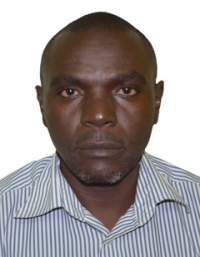Olivia Kituuka
ID:
|
HLA TYPING OF 5 MAJOR ETHNIC GROUPS IN UGANDA AND KNOWLEDGE AND ATTITUDES ABOUT ORGAN DONATION AND TRANSPLANTATION AMONG HEALTH CARE WORKERS, HEALTH POLICY MAKERS AND THE URBAN POPULATION IN UGANDA.
REFNo: HS1447ES
To determine the prevalence of Human Leucocyte Antigen (HLA) sub-types among individuals from five largest ethnic groups in Uganda. ,To assess Knowledge Attitudes and perceptions among urban populations and key stakeholders in Kampala city on organ transplantation in Uganda,
|
Uganda |
2021-06-23 |
2024-06-23 |
Medical and Health Sciences |
Non-Clinical Trial |
Non-degree Award |

|
Bernard Kikaire
ID:
|
Perspectives of stakeholders in research on post-trial access to investigative products: The Post Trial Access (PTA) Study
REFNo: HS1449ES
General Objective
To explore the understanding and perspectives of key research stakeholders about the provision of post-trial access in clinical trials conducted in Uganda.
Specific Objectives
1.To explore research stakeholders’ knowledge of post-trial access in Uganda
2.To explore research stakeholders’ perspectives about post-trial access in clinical trials conducted in Uganda.
3.To describe the post-trial access practices and or experiences among key research stakeholders in Uganda
|
Uganda |
2021-06-23 |
2024-06-23 |
Medical and Health Sciences |
Non-Clinical Trial |
Non-degree Award |

|
Shelley Jones
ID:
|
Women to Women Research for Economic Empowerment in Uganda: A Participatory Action Research Project
REFNo: SS710ES
The goal of this project is to engage women in Uganda in conducting research that investigates successful community-based, women-led entrepreneurial initiatives in order to inventory, analyze, and report on best practices and lessons learned that will contribute to knowledge that can be accessed by other women who are interested in entrepreneurship. The objectives are to support the participants to 1) develop research skills that will enable them to gain information, knowledge, and insights into how to develop thriving, sustainable initiatives that provide sufficient income to attain and sustain a reasonable standard of living; 2) create and disseminate knowledge around issues directly concerned with women’s empowerment through entrepreneurship
|
Canada |
2021-06-21 |
2024-06-21 |
Social Science and Humanities |
Non-Clinical Trial |
Non-degree Award |

|
Sam Ononge
ID: UNCST-2020-R000328
|
A PILOT STUDY TO EVALUATE THE PRELIMINARY SAFETY OF THE WEKEBERE SYSTEM FOR THE EARLY DETECTION OF PREGNANCY COMPLICATIONS.
REFNo: HS1025ES
To determine the safety of using the wekebere system in monitoring fetal wellbeing.
To determine the acceptability of the wekebere system among the expectant mothers and clinical staff.
|
Uganda |
2021-06-18 |
2024-06-18 |
Medical and Health Sciences |
Non-Clinical Trial |
Non-degree Award |

|
Irene Andia Biraro Rebecca
ID: UNCST-2019-R001475
|
A Randomized Double Blind Placebo Controlled Trial of Rifapentine and Isoniazid for Prevention of Tuberculosis in People with Diabetes.
REFNo: HS1112ES
Primary objective:
To assess the efficacy of preventive therapy with a 12-week course of rifapentine and isoniazid (3HP) against the development of probable or definite TB disease over 24 months in people with Diabetes Mellitus (DM) who are latent TB infection (LTBI) test positive.
Secondary objectives:
• To assess the efficacy of 3HP against the development of possible, probable or definite TB disease over 24-40 months in people with DM who are latent tuberculosis infection test positive
• To compare the proportions who complete treatment between arms
• To compare the occurrence of adverse events between arms
• To compare the rate of TB or death between arms
• To compare the overall mortality rate between arms
• To explore the efficacy of 3HP against development of probable or definite TB in those who are LTBI test positive, across the following sub-groups, separately: study site (n=3); age groups; duration of DM; level of glycaemic control (baseline HbA1C) and body mass index (BMI).
• To assess the efficacy of 3HP against development of probable or definite TB, in two restricted analyses: TST positive and IGRA positive participants.
• To carry out sub-studies including i) an economic modelling and cost effectiveness study, ii) a cohort study of those who are IGRA and TST negative a baseline, iii) a cross-sectional study of HIV and TB prevalence and DM phenotype, (iv) evaluation of point-of care (POC) testing for LTBI, and computer-assisted X-ray, (v) a public health study of patient management, and v) future genetic studies.
|
Uganda |
2021-06-18 |
2024-06-18 |
Medical and Health Sciences |
Clinical Trial |
Non-degree Award |

|
Elisabeth Vodicka
ID:
|
Evaluating the ongoing costs and operational context of national HPV vaccine delivery in Uganda
REFNo: HS1358ES
Identify the HPV vaccination program cost drivers and opportunities and challenges for improving cost efficiency.,Evaluate the quality of existing HPV vaccination program performance data.,Understand the contextual factors of the delivery approach for the HPV vaccination program.,Estimate the ongoing costs to deliver HPV vaccines for the health system and supporting platforms (e.g., department of education). ,Evaluate the annual ongoing financial and economic delivery costs for HPV vaccination in Uganda. ,
|
USA |
2021-06-18 |
2024-06-18 |
Medical and Health Sciences |
Non-Clinical Trial |
Non-degree Award |

|
FRANCIS TUMWESIGYE N/A
ID:
|
GENDER INCLUSION AND SERVICE PROVISION BY CORE SECURITY AGENCIES IN UGANDA. A CASE OF UGANDA POLICE IN KAMPALA METROPOLITAN AREA.
REFNo: SS779ES
TO EXAMINE THE EFFECTS OF WOMEN PARTICIPATION ON PROVISION OF SERVICES BY THE UGANDA POLICE FORCE.,TO FIND OUT THE BENEFITS OF WOMEN EMPOWERMENT ON PROVISION OF SERVICES BY THE UGANDA POLICE FORCE.,TO ASSESS THE IMPACTS OF WOMEN REPRESENTATION ON EFFECTIVE PROVISION OF SERVICES IN THE UGANDA POLICE FORCE.,TO EXAMINE THE EFFECTS OF GENDER EQUALITY ON EFFECTIVE PROVISION OF SERVICES BY THE UGANDA POLICE FORCE.,THE STUDY OUGHT TO EXAMINE THE EFFECTS OF GENDER INCLUSION AND PROVISION OF SERVICES BY THE UGANDA POLICE FORCE IN THE CONTEPOLARY POLICING.,
|
Uganda |
2021-06-18 |
2024-06-18 |
Social Science and Humanities |
Non-Clinical Trial |
Degree Award |

|
Thomas Baik
ID:
|
A Survey of Language Choice and Code Switching in Psychiatric and Neurological Practice
REFNo: HS1432ES
In this study we aim to explore three situations in which language choice can enhance multilingual patients’ cognitive reserve and psychological resilience. Research in psycho- and sociolinguistics suggests that languages can be used to regulate emotional and social distance. For example, one language can be associated with authority and formality, and other with compassion and solidarity (Myers-Scotton, 1995). This study aims to investigate whether such differential use of languages is also used in medicine and psychotherapy and can be applied to regulate inner emotions. This leads us to our research question: Can multilingualism benefit psychiatric and neurological patients through a mechanism of emotional distance regulation.
We will address language choice and code switching in the context of trauma and psychosis in psychotherapy as well as in the process of neurodegeneration in neurological patients. We aim to address the question of the importance of language choice in illness from all three perspectives of the biopsychosocial model, since each of the above-mentioned groups has one component of the biopsychosocial model in the foreground, meaning that in neurological patients the predominant component is biology, psychosis patients are strongly influenced by psychological factor and in trauma patients the experiences are strongly embedded in social factors.
|
Germany |
2021-06-18 |
2024-06-18 |
Medical and Health Sciences |
Non-Clinical Trial |
Degree Award |

|
Levicatus Mugenyi
ID: UNCST-2020-R014759
|
The Impact of Child-Optimized Financial Education (COFE) Curriculum in Uganda
REFNo: SS817ES
The main study objectives are to answer the following specific research questions/objectives. Outcomes/measures are underlined below.
Primary research question:
• Does participation in COFE + SILC groups increase the likelihood that caregivers pay for required education expenses of all the school-age children under the caregivers’ care to stay in school vs. participation in SILC only groups?
Secondary research questions include:
• Does participation in COFE + SILC increase the likelihood that caregivers pay for health-related expenses of all the children under the caregivers’ care (who have a health need) vs. participation in SILC alone?
• Does participation in COFE + SILC increase caregivers’ financial self-efficacy vs. participation in SILC alone?
|
Uganda |
2021-06-17 |
2024-06-17 |
Social Science and Humanities |
Non-Clinical Trial |
Non-degree Award |

|
Damalie Nalwanga
ID: UNCST-2021-R013217
|
Exploring understanding, attitudes and practices of frontline health workers and caretakers regarding the relationship between severe pneumonia and malnutrition in children in the context of COVID-19
REFNo: SS803ES
1.To assess the level of understanding of frontline health workers and caretakers regarding the relationship between severe pneumonia and malnutrition in the context of COVID -19
2.To assess the attitudes of frontline health workers and caretakers regarding the relationship between severe pneumonia and malnutrition in the context of COVID -19
3.To assess the practices of frontline health workers and caretakers regarding the relationship between severe pneumonia and malnutrition in the context of COVID -19
|
Uganda |
2021-06-16 |
2024-06-16 |
Social Science and Humanities |
|
Non-degree Award |

|
Emmy Okello
ID: UNCST-2020-R009792
|
Active Case Detection and Decentralized Dynamic Registry to Improve the Uptake of Rheumatic Heart Disease Secondary Prevention (ADD-RHD)
REFNo: HS1323ES
Primary Objective:
To develop and refine a technology-enabled approach to increase uptake of secondary prevention (ADD-RHD) that is sustainable and replicable at scale to improve outcomes for people living with RHD.
Secondary Objectives:
Aim 1: Optimize the ADD-RHD ACT Platform to maximize case retention and delivery of secondary prophylaxis.
Aim 2: Roll out and evaluate the implementation of the ACT Platform.
Aim 3: Assess the adequacy of current policy and regulatory guidance in Uganda for the adoption of new technologies for health in general, and for rheumatic heart disease diagnosis and management and to describe system and policy constructs necessary for the successful approval of new health technology.
Aim 4: Estimate costs, cost-effectiveness, and budget impact of the ACT platform intervention.
|
Uganda |
2021-06-16 |
2024-06-16 |
Medical and Health Sciences |
Non-Clinical Trial |
Non-degree Award |

|
Julius Okuni Boniface
ID: UNCST-2019-R000963
|
A MULTI-COUNTRY, SINGLE-BLINDED, PHASE 2 STUDY TO EVALUATE RAPID DETECTION SYSTEMS OF SARS-COV-2
REFNo: HS1425ES
1. To determine the clinical sensitivity of the test assays compared to the real-time RT-PCR-based method.
2. To determine the specificity of the test assays compared to the real-time RT-PCR-based method.
|
Uganda |
2021-06-16 |
2024-06-16 |
Medical and Health Sciences |
Clinical Trial |
Non-degree Award |

|
William Worodria Ofuti
ID: UNCST-2022-R010915
|
The effect of household air pollution on lung function recovery in COVID-19 disease
REFNo: SS892ES
Main objective
- The overall aim of the study is to measure the effect of air pollution on lung function recovery after COVID-19 pneumonia.
-Measure the effect of air pollution exposure on lung function recovery after COVID-19.
Specific Objectives
- Measure the effect of mobility on air pollution exposure and lung function recovery after COVID-19.
-
|
Uganda |
2021-06-16 |
2024-06-16 |
Social Science and Humanities |
Non-Clinical Trial |
Non-degree Award |

|
Moses Mulumba
ID: UNCST-2021-R013832
|
An Ethnographic Analysis of the Right to Health Based Monitoring of and Advocacy for the Progressive Realization of Universal Health Coverage in Uganda
REFNo: SS793ES
Study Goal
The goal of the project is to establish the extent to which OPERA plus PAR supports the localization of the right to health
Specific objectives
To build the capacity of civil society and influential academia on the use of the OPERA framework
To explore the current levels of enjoyment of the right to health in Uganda
To assess state commitments and efforts to fulfill the right to health including the use of adequate resources
To examine constraints to the state's compliance to fulfill the right to health.
|
Uganda |
2021-06-14 |
2024-06-14 |
Social Science and Humanities |
Non-Clinical Trial |
Non-degree Award |

|
Christine Wiltshire Sekaggya
ID: UNCST-2019-R000578
|
Establishing the prevalence of COVID19 infection among patients attending TB clinic, and the effect of COVID19 on TB clinical care in Kampala
REFNo: HS1304ES
Primary objective:
1. To determine the prevalence of COVID-19 infection amongst adult patients attending TB clinics
Secondary objectives
1. To determine the prevalence of previous COVID-19 infection amongst adult patients attending TB clinics
2. To explore the experiences of patients attending TB clinic during the COVID-19 pandemic
3. To explore the experiences of healthcare workers in relation to TB care provision during the COVID-19 pandemic
|
Uganda |
2021-06-11 |
2024-06-11 |
Medical and Health Sciences |
|
Non-degree Award |
.png)
|
Arthur Bagonza
ID:
|
EFFECTIVENESS OF SUPPORT GROUPS ON IMPROVING LIVELIHOOD OF PEOPLE WITH ALBINISM IN
UGANDA
REFNo: SS882ES
1. To map and profile all PWA and service providers of PWA in three regions (Northern, Western and Central) Uganda.
2. To construct a model of group support for PWA in three regions of Uganda based on views of PWA.
3. To determine the effectiveness of support groups on increasing access to services and inclusion of People with Albinism in mainstream development processes in Uganda.
4. To explore perceptions of key stakeholders on the use of support groups in increasing access to services and inclusion in mainstream development processes for PWA in Uganda
|
Uganda |
2021-06-11 |
2024-06-11 |
Social Science and Humanities |
Non-Clinical Trial |
Non-degree Award |

|
Romeo Gichohi wahome
ID:
|
EFFECTIVENESS OF IMPROVISED CARDBOARD SPLINTS AS AN ALTERNATIVE TO PLASTER OF PARIS IN THE EMERGENCY TREATMENT OF LOWER LIMB FRACTURES
REFNo: HS1357ES
General Objective
1. To determine whether improvised cardboard
splints are a viable effective
alternative to plaster of Paris splints
for lower limb fractures in Mbarara
Regional and Referral
Hospital.
Specific Objectives
1. To compare the clinical effectiveness of immobilization between improvised cardboard
and plaster of Paris splint in lower limb fractures.
2. To compare the time and resource costs between improvised cardboard and plaster of
Paris in splinting of lower limb fractures.
|
Kenya |
2021-06-11 |
2024-06-11 |
Medical and Health Sciences |
Non-Clinical Trial |
Degree Award |

|
Dennis Muhanguzi
ID: UNCST-2019-R001101
|
Accelerating Anti-Tick Vaccine Production Using Computational Approaches and Validation with An In-Vivo Model
REFNo: NS165ES
The specific objectives of this study will be to;
i.Create an open access queryable database of candidate anti-tick vaccine protein from I. scapularis proteome
ii.Identify single and chimeric antigenic anti-tick peptides basing on tick-specific amino acid sequences
iii.Evaluate the immunogenicity of five of the most promising antigenic single and chimeric anti-tick peptides in a laboratory animal [three months New Zealand rabbits] model
|
Uganda |
2021-06-10 |
2024-06-10 |
Natural Sciences |
|
Non-degree Award |

|
Jerome Kabakyenga Kahuma
ID: UNCST-2021-R013729
|
Smart discharges to improve post-discharge health outcomes in children below 6 months old
REFNo: SS855ES
To determine the effectiveness of a Smart Discharge program on post-discharge health seeking behavior and mortality among children under 6 months of age admitted with a proven or suspected infection.
|
Uganda |
2021-06-08 |
2024-06-08 |
Social Science and Humanities |
Non-Clinical Trial |
Non-degree Award |

|
Musa Sekikubo
ID: UNCST-2021-R014010
|
A multi-Centre, randomised, placebo controlled, double-blind, parallel group study to evaluate the safety, tolerability and immunogenicity of two doses of Group B Streptococcus vaccine (GBS-NN/NN2) in women who are pregnant and living with HIV and women who are pregnant and do not have HIV
REFNo: HS1390ES
Objectives
Primary Objectives:
Safety:
To evaluate the safety and tolerability of the GBS-NN/NN2 vaccine in women living with HIV and women without HIV and their newborn babies from vaccination up to delivery/birth.
Immunological:
To compare the transfer rate of vaccine- specific immunoglobulin G (IgG) antibody concentrations from the mother to the baby at birth in women living with HIV with the transfer rate in women without HIV. This endpoint will be used to determine the sample size calculation.
Secondary Objectives
Safety: The safety and tolerability of the GBS-NN/NN2 vaccine in the mother and baby over the first 6 months post-partum, as assessed at 6 months of age.
Immunological: The secondary immunological objectives are:
• To compare IgG antibody responses, specific to the GBS-NN/NN2 vaccine, induced by the first and second vaccine doses over time in pregnant women living with HIV and pregnant women without HIV.
• To evaluate the concentration of IgG antibodies specific for the GBS-NN/NN2 vaccine up to 6 months post-delivery in the mother and baby in women with and without HIV.
• To determine the concentrations of vaccine specific IgG to GBS-NN/NN2 in cord blood at delivery in babies born to women with and without HIV.
Exploratory Objectives
• To compare between groups the isotype composition of the vaccine specific antibodies; in particular IgG and IgA as well as their subclasses, i.e. IgG1-4, IgA1 and IgA2 in maternal and cord blood.
• To compare between groups the vaccine specific IgG antibodies to Rib, Alp1, Alp2 and AlpC, GBS-NN and GBS-NN2 in maternal and cord blood.
• To compare between groups the functional activity of vaccine specific antibodies from cord blood in an opsonophagocytic killing assay (OPkA) and other in vitro assays in selected samples.
|
Uganda |
2021-06-08 |
2024-06-08 |
Medical and Health Sciences |
Clinical Trial |
Non-degree Award |

|
| View |
|
Sort By: |
|
|
|
| |
|